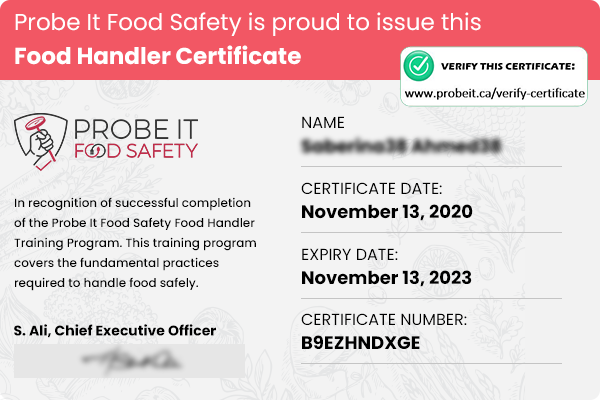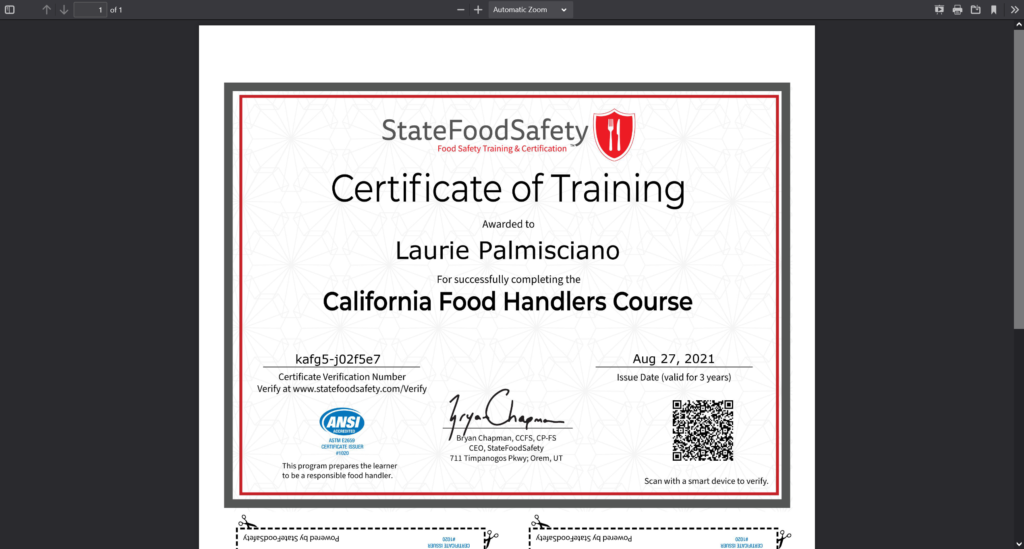ServSafe Food Handler: Everything You Need to Know for Certification
ServSafe Food Handler: Everything You Need to Know for Certification
Blog Article
How to Obtain Your Food Handler Qualification Quickly and Easily
Getting your food handler qualification can appear challenging, yet with a calculated technique, it can be achieved efficiently. Food Handler Certification. What are the most reliable methods to ensure not only a successful accreditation however also recurring compliance in the ever-evolving landscape of food security?
Understand Certification Needs
Getting a food trainer accreditation needs a clear understanding of the specific demands stated by regional health authorities and regulatory agencies. Each jurisdiction may enforce various criteria and assumptions, so it is vital to research the regulations suitable to your area. Normally, these demands include finishing an authorized training program, passing an accreditation examination, and in some cases restoring the qualification occasionally.
First, familiarize on your own with the neighborhood legislations regulating food safety and security and handling. This may entail visiting the web site of your local wellness department or contacting them directly for guidance. In addition, some regions might have certain age requirements or academic prerequisites, such as a minimum level of education.
When you understand the demands, make sure that the training program you choose is identified by your regional wellness authorities. This acknowledgment assures that the curriculum satisfies the necessary guidelines for reliable training in food safety and security techniques.
Pick the Right Training Course
Just how can you guarantee that you choose the most ideal food trainer certification training course for your needs? Beginning by evaluating the training course's certification. Verify that it is recognized by your regional health division or regulatory body, as this makes sure the certification will stand for employment in your location.
Following, think about the layout of the program. Some people may prefer in-person training for its interactive components, while others may choose on-line courses for comfort and flexibility. Review the course material to ensure it covers crucial topics such as food safety principles, individual hygiene, cross-contamination, and appropriate food storage space.
Furthermore, try to find training courses that use an extensive evaluation and practice tests, which can improve your understanding and retention of the material. Check the period of the training course and ensure it aligns with your routine. Review testimonials or reviews from previous individuals to evaluate the training course's performance and quality. By meticulously assessing these aspects, you can select a food handler qualification program that fulfills your details demands and prepares you sufficiently for your duty in the food service industry - ServSafe Food Handler.
Full the Training
Upon selecting the suitable food trainer accreditation course, the next essential action is to finish the training. This training is created to outfit you with vital knowledge concerning risk-free food handling techniques, hygiene, and sanitation protocols. Most courses use a mix of on the internet modules, videos, and interactive quizzes, permitting an adaptable discovering experience that can be tailored to your schedule.
Some courses might likewise provide instance research studies or real-life situations to improve your understanding. This sensible application of understanding is critical, as it prepares you for the difficulties you might deal with in a food solution environment.
In addition, guarantee that you designate adequate time to finish each module thoroughly before going on to the next. Hurrying through the material can result in gaps in understanding, which might hinder your efficiency in future analyses. Completing the training with diligence will certainly not only help with a smoother transition to the following action in acquiring your qualification yet likewise make sure that you are well-prepared to maintain food safety navigate here criteria in your expert role.
Pass the Certification Examination
After successfully finishing your food handler training, the next essential action is to pass the qualification examination. This evaluation is developed to analyze your understanding of food safety and security principles, methods, and policies that are important in the food service market.
To prepare successfully, examine the products offered throughout your training completely. Focus on key subjects such as correct food storage, sanitation practices, cross-contamination avoidance, and personal hygiene standards. Many training programs provide practice tests, which can substantially boost your preparedness for the real test.


When taking the accreditation examination, guarantee you comprehend the format-- whether it consists of multiple-choice questions, true/false declarations, or practical scenarios. ServSafe Food Handler Certification. Review each concern meticulously and handle your time sensibly, permitting cautious factor to consider of each solution
If you experience difficult concerns, don't be reluctant to eliminate plainly incorrect choices to enhance your opportunities of choosing the right answer. After finishing the test, review your responses if time permits.

Maintain Your Certification
Maintaining your food handler accreditation is important for ensuring continuous conformity with sector requirements and policies. Qualification normally comes with certain needs, consisting of renewal timelines and proceeding education. It is crucial to stay notified regarding these commitments to avoid lapses in your qualifications.
The majority of territories call for food trainers to restore their certification every three to 5 years. This process commonly entails completing a refresher course or re-taking the certification exam. Routinely examining your qualification's expiration date can help you avoid any type of possible disturbances in your capability to operate in food solution.
Furthermore, staying upgraded on best techniques and changes in food safety and security regulations is vital. Taking part in workshops, attending sector workshops, or registering for pertinent newsletters can boost your understanding and maintain you educated regarding the most up to date patterns and compliance demands.
Lastly, preserving a tidy document in food handling techniques is just as essential. Paper any kind of occurrences, training sessions, and best techniques you implement at your workplace, as this can offer as a beneficial source throughout renewal or inspections. By proactively check my site engaging in these practices, you make certain not just the honesty of your certification but additionally the safety and satisfaction of your consumers.
Final Thought
Getting food trainer accreditation requires a systematic technique that includes understanding local demands, choosing an ideal program, finishing training, and passing the qualification test. By complying with these steps faithfully, people can ensure they are furnished Click This Link with the necessary expertise and skills to support food security criteria in their corresponding environments.
How can you ensure that you pick the most ideal food handler accreditation training course for your demands? Review the program content to ensure it covers essential subjects such as food security concepts, individual health, cross-contamination, and appropriate food storage space.
By thoroughly analyzing these aspects, you can pick a food handler certification course that fulfills your particular requirements and prepares you effectively for your role in the food service industry.
Upon picking the ideal food trainer certification training course, the next crucial step is to finish the training.Obtaining food handler qualification requires a methodical method that consists of understanding regional needs, selecting a proper program, finishing training, and passing the certification test.
Report this page